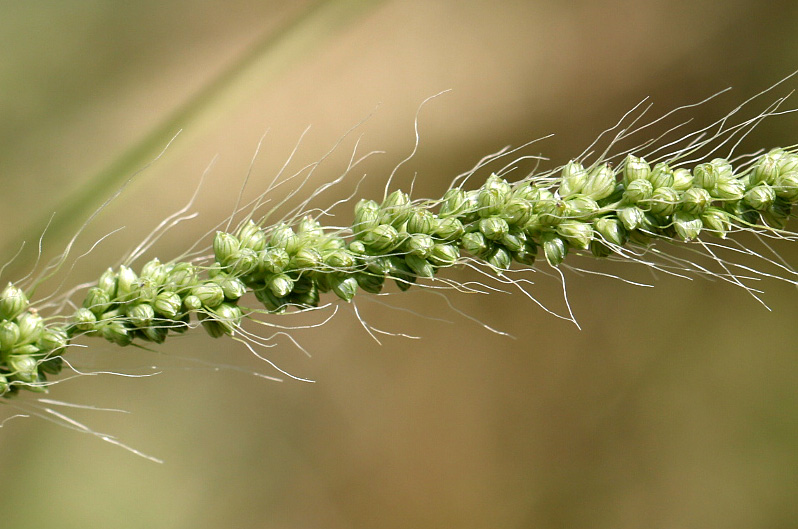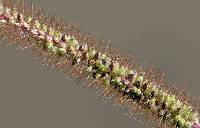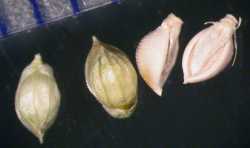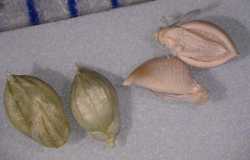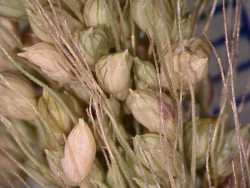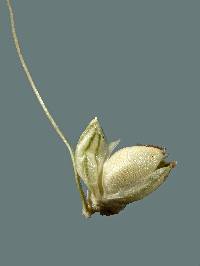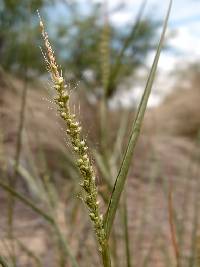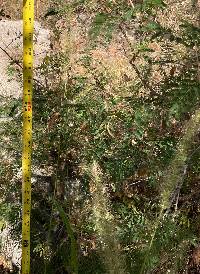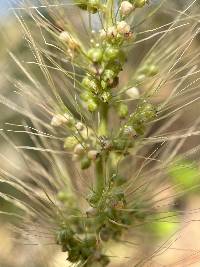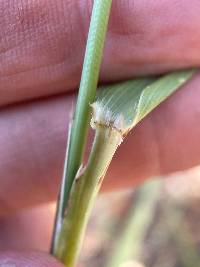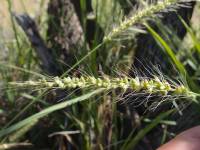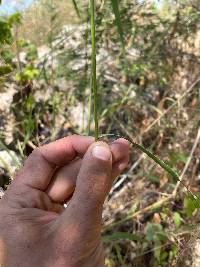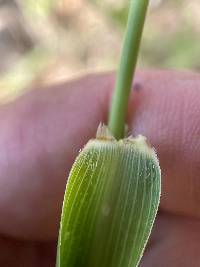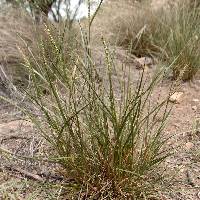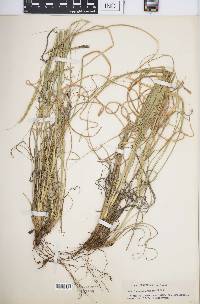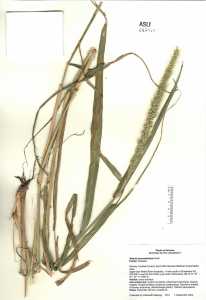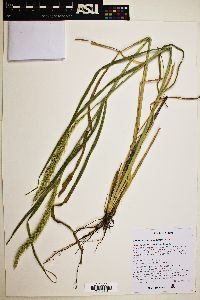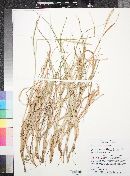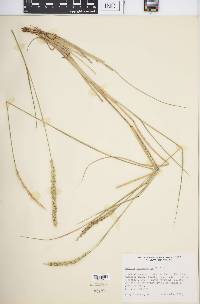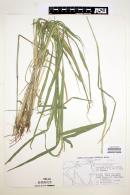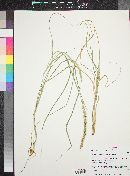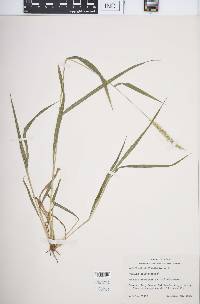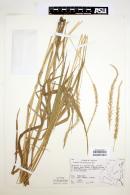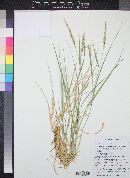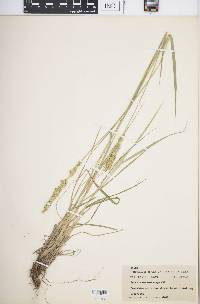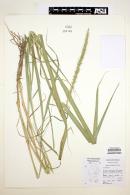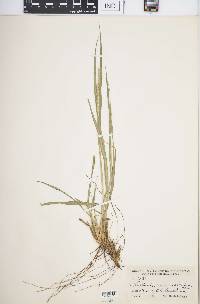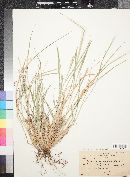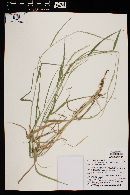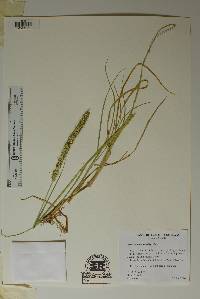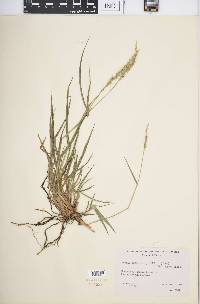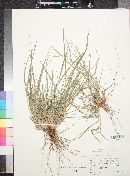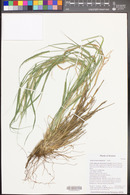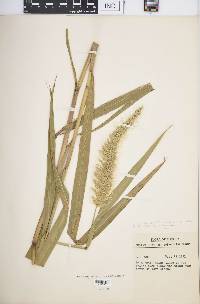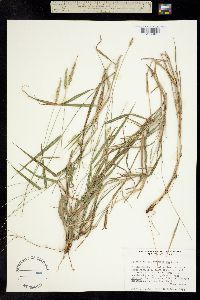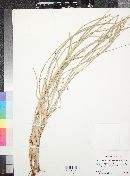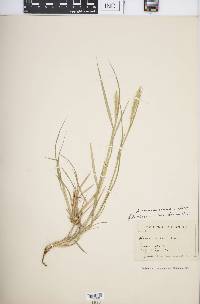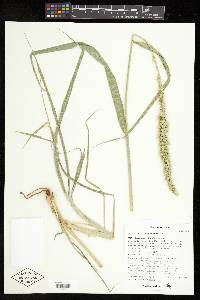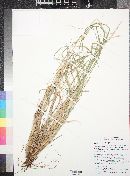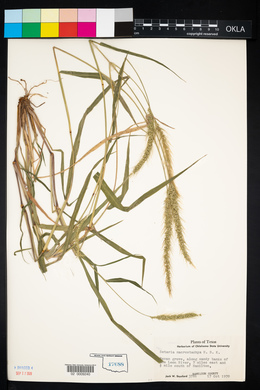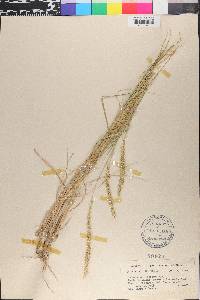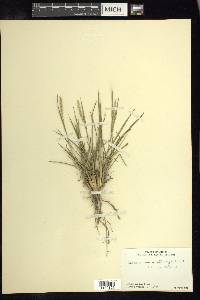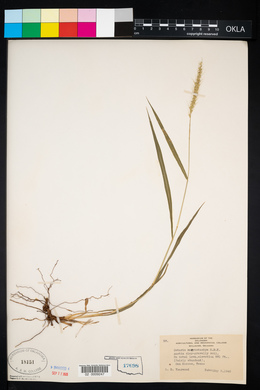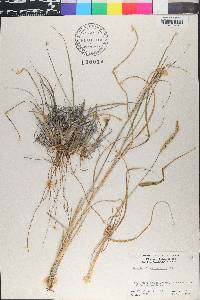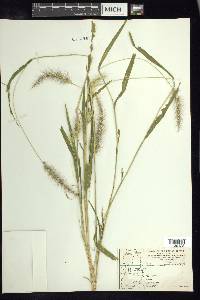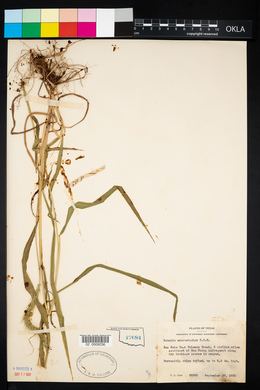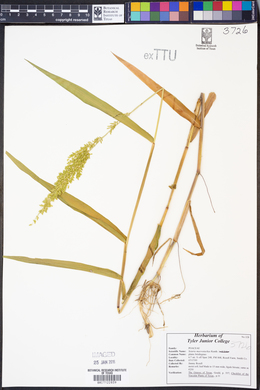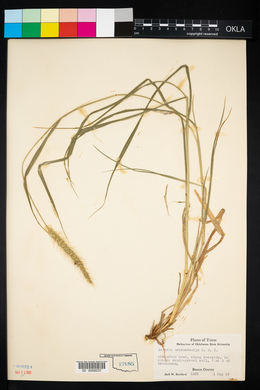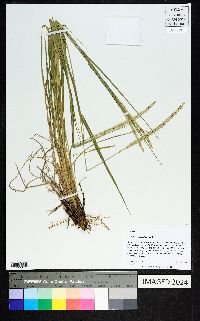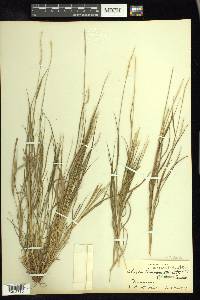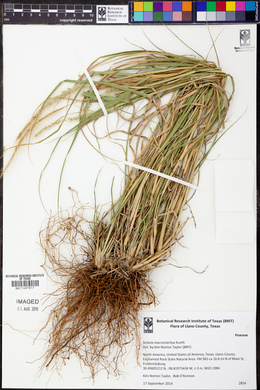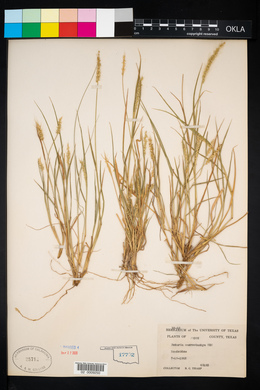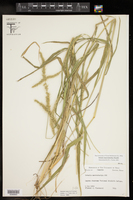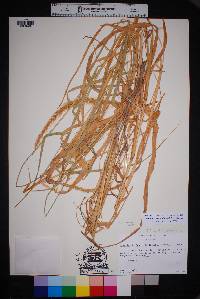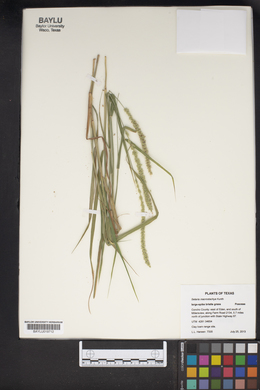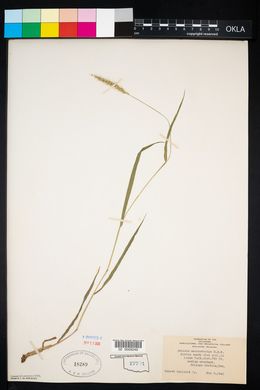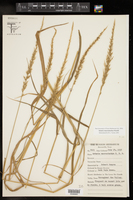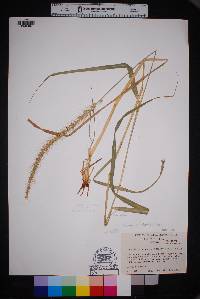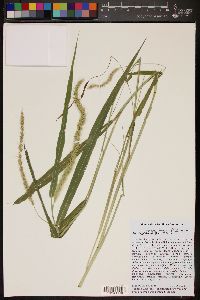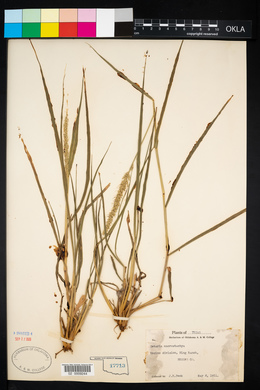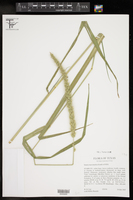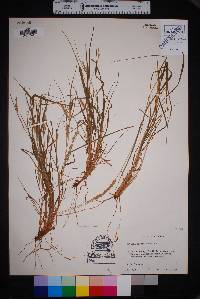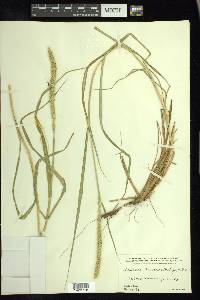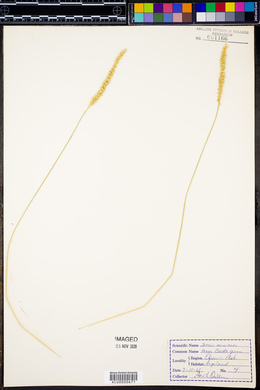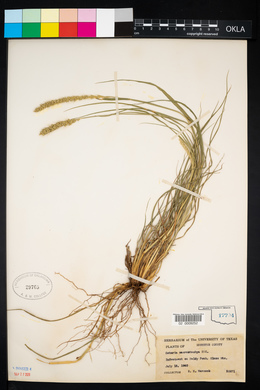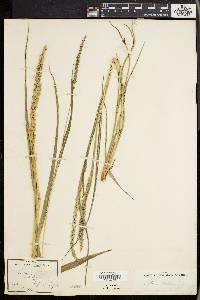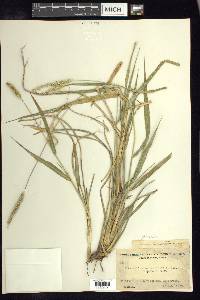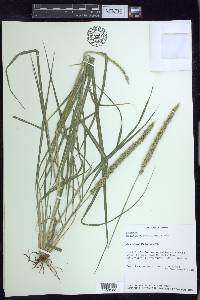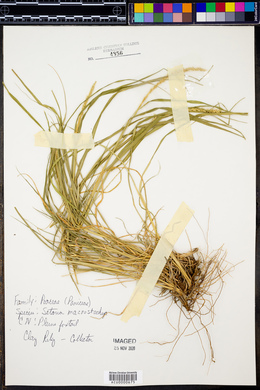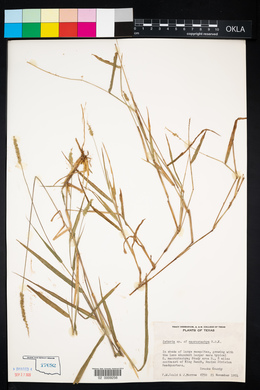Setaria macrostachya
|
|
|
|
Family: Poaceae
Large-Spike Bristle Grass, more...plains bristlegrass (es: zacate tempranero)
[Chaetochloa gibbosa Scribn. & Merr., moreChaetochloa macrostachya (Kunth) Kuhlm., Chamaeraphis macrostachya (Kunth) Kuntze ex Stuck., Chamaeraphis setosa var. macrostachya (Kunth) Kuntze, Panicum macrostachyum (Kunth) Döll, Panicum macrostachyum var. patens Döll, Setaria berlandieri R.A.W. Herrm., Setaria caudata var. pauciflora M.E. Jones, Setaria gibbosa (Scribn. & Merr.) Schum., Setaria italica var. macrostachya (Kunth) Mathieu] |
Plants perennial; densely cespitose. Culms 60-120 cm, rarely branched distally, scabrous below the nodes and panicles. Sheaths keeled, glabrous, usually with a few white hairs at the throat; ligules 2-4 mm, densely ciliate; blades 15-20 cm long, 7-15 mm wide, flat, adaxial surface scabrous. Panicles 10-30 cm long, 1-2 cm wide, uniformly thick from the base to the apex, dense, rarely lobed basally; rachises scabrous and loosely pilose; bristles usually solitary, 10-20 mm, soft, antrorsely scabrous. Spikelets 2-2.3 mm, subspherical. Lower glumes 1/3-1/2 as long as the spikelets, 3-5-veined; upper glumes about 3/4 as long as the spikelets, 5-7-veined; lower lemmas equaling the upper lemmas, 5-veined; lower paleas nearly equaling the upper paleas in length and width; upper lemmas transversely rugose; upper paleas convex, ovate. 2n = 54. Setaria macrostachya is abundant in the desert grasslands of the southwestern United States, particularly in southern Arizona and Texas. It extends south through the highlands of central Mexico. It also grows in the West Indies, but is not common there. It is a valuable forage grass in the Flora region. Dr. David Bogler, USDA NRCS PLANTS Database Perennials, Terrestrial, not aquatic, Stems nodes swollen or brittle, Stems erect or ascending, Stems geniculate, decumbent, or lax, sometimes rooting at nodes, Stems caespitose, tufted, or clustered, Stems terete, round in cross section, or polygonal, Stem internodes solid or spongy, Stem internodes hollow, Stems with inflorescence less than 1 m tall, Stems with inflorescence 1-2 m tall, Stems, culms, or scapes exceeding basal leaves, Leaves mostly cauline, Leaves conspicuously 2-ranked, distichous, Leaves sheathing at base, Leaf sheath mostly open, or loose, Leaf sheath smooth, glabrous, Leaf sheath hairy at summit, throat, or collar, Leaf sheath or blade keeled, Leaf sheath and blade differentiated, Leaf blades linear, Leaf blades 2-10 mm wide, Leaf blades 1-2 cm wide, Leaf blades mostly flat, Leaf blades mostly glabrous, L eaf blades scabrous, roughened, or wrinkled, Ligule present, Ligule a fringe of hairs, Inflorescence terminal, Inflorescence a contracted panicle, narrowly paniculate, branches appressed or ascending, Inflorescence a dense slender spike-like panicle or raceme, branches contracted, Inflorescence solitary, with 1 spike, fascicle, glomerule, head, or cluster per stem or culm, Inflorescence spike linear or cylindric, several times longer than wide, Peduncle or rachis scabrous or pubescent, often with long hairs, Flowers bisexual, Spikelets pedicellate, Spikelets dorsally compressed or terete, Spikelet less than 3 mm wide, Spikelets with 1 fertile floret, Spikelets with 2 florets, Spikelet with 1 fertile floret and 1-2 sterile florets, Spikelets solitary at rachis nodes, Spikelets all alike and fertille, Spikelets bisexual, Spikelets disarticulating below the glumes, Spikelets all subtended by bristles, Spikelet bristles 1-3, Spikelet bracts bristles not disarticulating with s pikelets, Rachilla or pedicel glabrous, Glumes present, empty bracts, Glumes 2 clearly present, Glumes distinctly unequal, Glumes shorter than adjacent lemma, Glumes 3 nerved, Glumes 4-7 nerved, Lemmas thin, chartaceous, hyaline, cartilaginous, or membranous, Lemma similar in texture to glumes, Lemma becoming indurate, enclosing palea and caryopsis, Lemma 5-7 nerved, Lemma glabrous, Lemma rugose, with cross wrinkles, or roughened, Lemma apex acute or acuminate, Lemma awnless, Lemma margins thin, lying flat, Lemma straight, Palea present, well developed, Palea shorter than lemma, Palea 2 nerved or 2 keeled, Stamens 3, Styles 2-fid, deeply 2-branched, Stigmas 2, Fruit FNA 2003, Gould 1980, Kearney and Peebles 1969 Common Name: large-spike bristlegrass Duration: Perennial Nativity: Native Lifeform: Graminoid General: Densely tufted perennial grass with stems 60-120 cm tall; stems rarely branched above, somewhat geniculate, scabrous below the nodes and panicles. Vegetative: Blades 15-20 cm long, 7-15 mm wide, flat, with scabrous upper surface; ligules densely ciliate, 2-4 mm, with tuft of hair on either side; sheaths keeled, glabrous except for a few white hairs at the throat. Inflorescence: Dense spicate panicle 10-30 cm long, 1-2 cm wide, uniformly thick from base to apex, dense; rachises scabrous and loosely pilose; bristles, 10-20 mm, soft, antrorsely scabrous and pale green, solitary or paired at the base of each spikelet; spikelets 2-2.5 mm, subspherical, pale green, and 2-flowered, the first floret sterile or staminate and the second floret fertile; lower glume one third to half as long as spikelet, 3-5 veined; upper glume about three quarters as long as spikelets, 5-7 veined; fertile lemma reticulate and moderately rugose, often with fine transverse ridges. Ecology: Found on dry flats and in washes, often in partial shade of trees and shrubs, from 3,500-7,000 ft (1067-2134 m); flowers May-October. Distribution: sw US in NV, AZ, CO, NM, TX; south to s MEX and S. Amer. Notes: Setaria spp. have inflorescences with short, mostly contracted branches and single-seeded, hard spikelets subtended by persistent bristles that remain on the plant after the spikelets have fallen. S. macrostachya is distinguished by being an often robust, erect perennial to 1.5 m tall, leaves 7-15 mm wide, columnar spike-like panicles 10-30 cm long, and spikelets that are very rounded on the back (subspherical; see pic). S. leucopila is nearly identical but differs by often having a shorter height (to 1 m); narrower leaves (< 5 mm); usually shorter inflorescences (6-15 cm); and spikelets which resemble an elongated hemisphere (elliptical). Ethnobotany: Unknown Etymology: Setaria is from Latin saeta, a bristle or hair, while macrostachya comes from Greek macro for large and stachys for an ear of grain, referring to the large spike. Synonyms: None Editor: SBuckley 2010, AHazelton 2015 |
|
|
|

